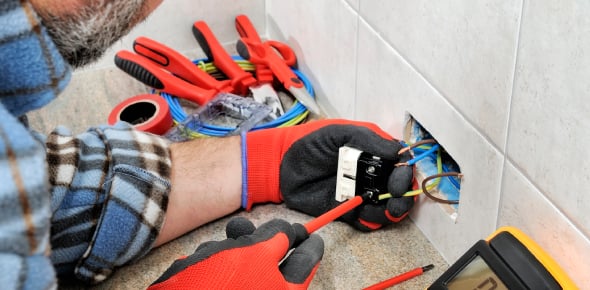Some types of heaters may be illegal in specific types of occupancies.
Wet chemical fire protection systems are recommended for electrical...
Which of the following materials is NOT a good conductor?
A street, alley, or parcel of land essentially open to the outside and...
Connecting two object that conduct electricity with another conductor
Occupancy classifications are based on the premise that certain types...
The dust hogger is the most common location of fires in woodworking...
What a building is used for
The primary difference between BOCA Type 1 & BOCA Type 2...
Maintaining a relative humidity of 60 to 70 percent greatly reduces...
The mechanical equipment in an HVAC system must be enclosed in a...
Why is battery recharging especially hazardous?
What is the most common cause of fires & explosions in...
Which of the following is NOT a special concern regarding fires where...
How does NFPA 101 classify a college dormitory?
That portion of a means of egress between the end of an exit and a...
Stairway designed to limit the penetration of smoke, heat, and toxic...
Incineration is effective in destroying medical, chemical, and...
How are metal pieces removed from wood dust or conveyors?
Connecting an object that conducts electricity to the ground with...
Inside storage of tires should be in accordance with local code...
If a building has different uses that are intermingled throughout the...
Buildup of paint materials on walls of a spray booth can act as an...
Dipping processes should be located in an egress area whenever...
A fire inspector must actually visit a site proposed for open burning...
Currents of less than 200 milliamperes cannot cause death
HPM's may be stored in specially designed rooms within the...
The finishing area of an occupancy includes the interiors of the spray...
The primary difference between UBC Type III one hour & UBC Type...
SBC construction Types 1 & 2 are similar to BOCA Types I & 2.
Which of the following does NFPA 101 NOT classify as an industrial...
That portion of a means of egress that leads to the exit
The containers used in a dry-chemical fire protection system are...
What does I stand for in Ohm's Law (E=I.R)?
NFPA Type IV construction
Which of the following statements regarding hazards associated with...
SBC Type V construction is also known as ___________
Means of egress to an area of refuge at approximately the same level...
Which of the following is NOT typically included in regulations that...
Electrical pressure
During warehouse inspections, fire inspectors should gather...
Structural members are constructed, chemically treated, covered, or...
Resistance in an electrical circuit
NFPA Type 1 construction
SBC Type VI construction is also known as
Continuous and unobstructed way of exit travel from any point in a...
Which of the following statements is correct?
What NFPA construction classification has interior structural members...
An active smoke control system may exhaust combustion products through...
How does NFPA 101 classify a residential custodial care facility?
Most electrical fires are caused by static discharge
How a building is constructed
NFPA Type V construction
Which UBC construction classification calls for structural elements of...
The only major difference between NFPA Type 1 & NFPA Type II...
According to NFPA 101, which of the following is usually NOT a...
The first in a series of dust explosions is usually the most severe.
What resource should a fire inspector consult for specific...
What size timers does SBC Type III require for supporting roof &...
Making sure that incompatible products are kept away from each other...
Which of the following statements concerning powered industrial trucks...
Which of the following statements regarding tire storage operations is...
What NFPA class of assembly occupancies can accomodate 300 - 1,000...
What are the two main hazards associated with recycling plants?
NFPA Type II construction
For open yard storage, what is the maximum recommended height for...
What NFPA construction classification has exterior walls and...
What minimum number of residents does NFPA 101 require to classify a...
In the NFPA construction classification Type IV-2HH what does the 2...
In the NFPA construction classification Type I-443, what does the 3...
What BOCA construction classification allows unprotected structural...
Metal dusts present a considerably lower explosion hazard than grain...
What are the maximum recommended dimensions for a driveway grid in an...
NFPA Type III construction
In the NFPA construction classification Type IV-2HH, what does the...
What additional BOCA construction classification allows unprotected...
How does NFPA 101 classify a college classroom building with rooms for...
Class 2 HVAC filters, when clean, will not contribute to a fire and...
Any oil quenching tank over 150 gallons must have a bottom drain that...
Which of the following statements about semiconductor and electronics...
What NFPA standard addresses types of building construction?
Which of the following characteristics of electricity corresponds to...
When can static discharge occur?
That portion of a means of egress that is separated from the area of...
UBC Type IV buildings may have temporary partitions.
Which of the following is NOT a subgroup of UBC ratings?
What is the fire inspector's primary concern at woodworking...
Small pieces of metal that wear off woodworking machinery during...
NFPA 101 includs as educational occupancies all buildings whose...
If a building has two different uses in distinctly different areas,...
Fire in approved burn containers should not be within 50 feet of a...
How does NFPA 101 classify a university classroom?
What NFPA construction classification has structural members including...
Driveways between lumber stacks in an open-storage lumber yard should...
A nonflowing electrical charge
Shop rags or towels stored in welding or cutting areas should be kept...
Which means of ionizing the air to dissipate static charges is...
A hot work program should include a form that requires the person...
What two subgroups does the Standard Building Code employ?
The primary difference between SBC Types I/II & SBC Type IV is...
















